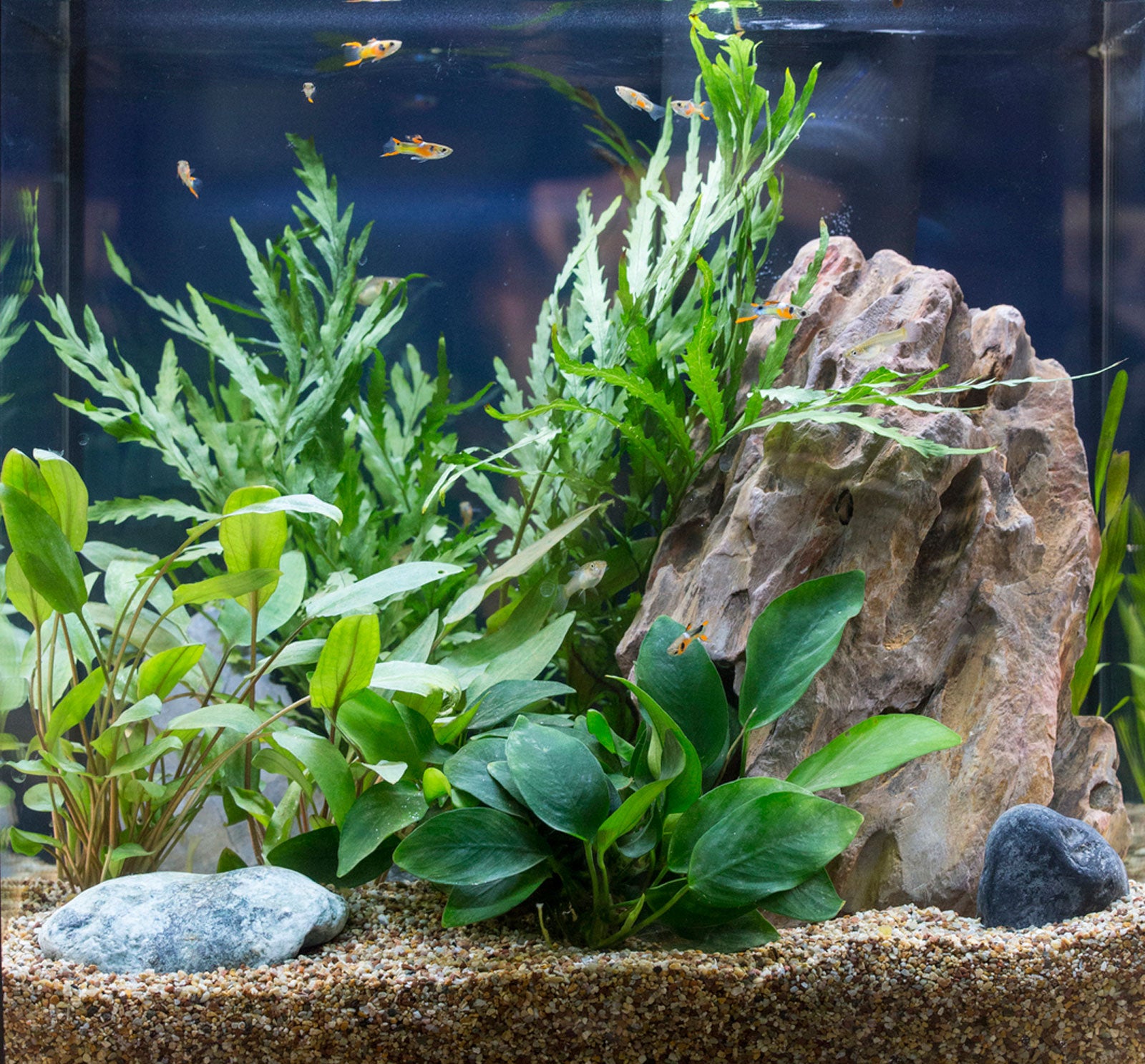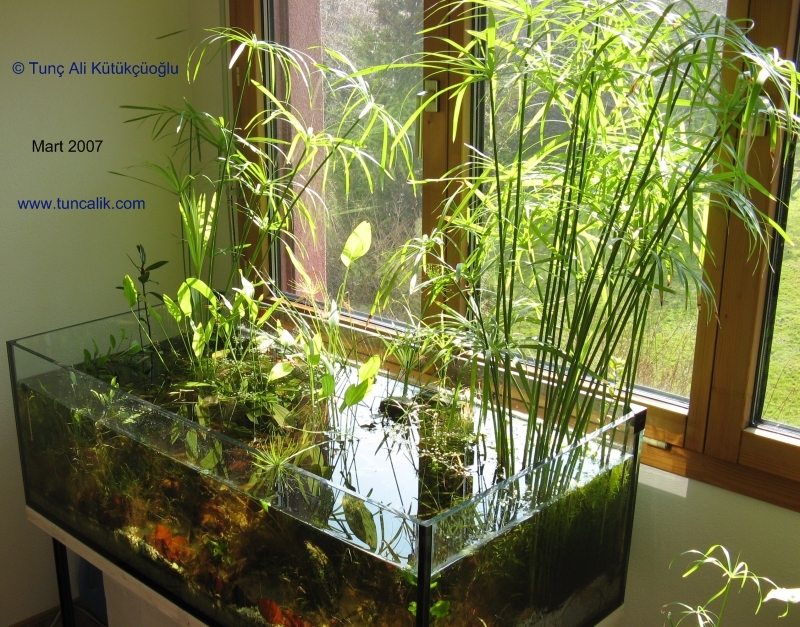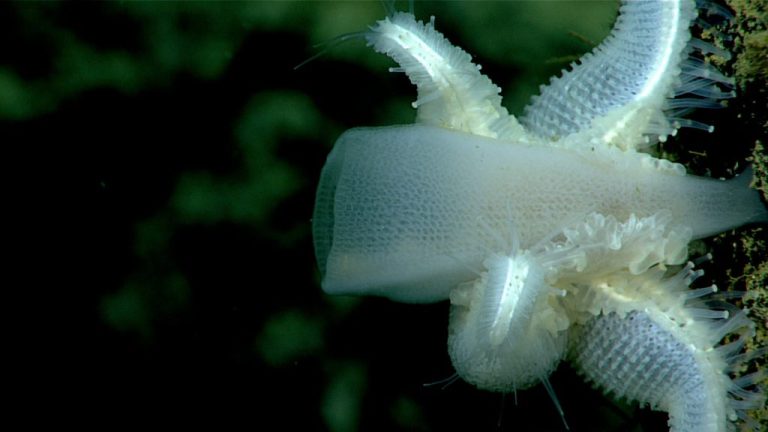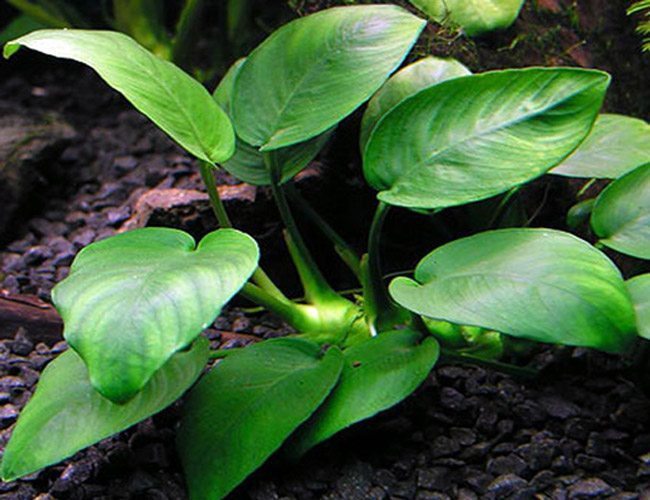Land Plants That Can Grow in Aquarium: Top 10 Choices
Some land plants can adapt to underwater conditions in aquariums. Popular choices include Anubias, Java Fern, and Peace Lily.
Aquarium enthusiasts often seek versatile plants to enhance their tanks. While aquatic plants are common, some land plants can also thrive underwater. Anubias and Java Fern are popular because they require low maintenance and grow well in submerged conditions. Peace Lily, with its striking leaves, can partially submerge and add aesthetic value.
These plants not only beautify the tank but also provide essential oxygen and hiding spots for fish. Proper care and attention ensure these land plants flourish in aquariums, creating a vibrant and healthy environment for aquatic life.

Credit: www.gardeningknowhow.com
Introduction To Aquarium Plants
Many people love aquariums with fish and plants. These plants make the tank look beautiful. They also help keep the water clean. Some plants grow well in water. Others grow better on land. Both types can live in aquariums.
Benefits Of Aquarium Plants
Plants in aquariums have many benefits. They give oxygen to the water. This helps the fish breathe better. Plants also remove toxins from the water. They act like a filter. This keeps the water clean and healthy.
Plants provide hiding spots for fish. This makes fish feel safe. Some fish eat the plants. This gives them a natural diet. Plants can also reduce algae growth. Algae can make the tank dirty and unhealthy.
Choosing The Right Plants
Choosing the right plants is important. Some plants need more light. Others need less. Check if the plant needs special care. Look at the size of the plant. Some plants grow very big. Small plants are good for small tanks.
Here are some tips:
- Light Requirements: Check if the plant needs high or low light.
- Water Conditions: Make sure the plant can live in your tank’s water.
- Growth Rate: Some plants grow fast, others grow slow.
- Tank Size: Choose plants that fit well in your tank.
Here is a table of popular aquarium plants:
| Plant Name | Light Needs | Growth Rate |
|---|---|---|
| Java Moss | Low | Slow |
| Anubias | Low | Medium |
| Aquatic Fern | Medium | Fast |
Choose the right plants for your aquarium. This will help your fish and plants live happily together.
Java Fern
The Java Fern is a popular choice for aquarium enthusiasts. This hardy plant can thrive in a variety of conditions. It adds a lush, green touch to any tank. Java Fern is easy to grow and requires minimal care.
Planting And Care
Java Fern is simple to plant. Attach it to rocks or driftwood using thread or fishing line. Do not bury its rhizome in the substrate. This can cause root rot.
Once attached, the plant will anchor itself over time. Java Fern grows slowly but steadily. Trim dead leaves regularly to promote healthy growth. Use sharp scissors to prevent damage.
Java Fern does not need CO2 injection. It can absorb nutrients directly from water. Fertilizers can enhance its growth, but they are not necessary.
Ideal Aquarium Conditions
Java Fern thrives in a wide range of water conditions. It prefers a temperature between 68°F and 82°F (20°C – 28°C). The pH level should be between 6.0 and 7.5.
Java Fern does well in low to moderate light. High light can cause algae growth on its leaves. Use a timer to ensure consistent lighting.
The plant can tolerate a variety of water hardness levels. Soft to moderately hard water is ideal. Ensure good water circulation to prevent stagnant areas.
| Parameter | Ideal Range |
|---|---|
| Temperature | 68°F – 82°F (20°C – 28°C) |
| pH Level | 6.0 – 7.5 |
| Light | Low to Moderate |
| Water Hardness | Soft to Moderately Hard |
Anubias
Anubias is a popular aquarium plant known for its hardiness. It thrives both submerged and partially submerged. This versatile plant adds beauty to any aquarium setup.
Planting And Care
Planting Anubias is easy. It does not need substrate. You can attach it to rocks or driftwood. Use fishing line or thread to secure it.
Anubias prefers low to moderate lighting. Too much light can cause algae growth. Keep the light on for 8-10 hours daily.
This plant grows slowly. It needs minimal fertilization. Use liquid fertilizers sparingly.
Compatibility With Fish
Anubias is compatible with many fish species. It is sturdy and can withstand nibbling. It provides hiding spots for small fish.
This plant is suitable for community tanks. It coexists well with other plants. It can be a great addition to a betta fish tank.
Anubias is also safe for shrimp and snails. It does not produce harmful chemicals. It helps maintain a balanced ecosystem.
Amazon Sword
The Amazon Sword is a popular plant for aquariums. It is known for its lush green leaves. This plant can thrive underwater and in moist soil. It is easy to care for and adds beauty to any tank.
Growth And Maintenance
The Amazon Sword grows quickly in the right conditions. It needs good light and nutrients. The leaves can grow up to 20 inches long. Keep the water temperature between 72°F and 82°F. Use a liquid fertilizer to support its growth.
Trim dead or yellow leaves to keep the plant healthy. Use sharp scissors to make clean cuts. This helps the plant grow new leaves. The Amazon Sword also needs iron. You can add iron supplements to the water.
Aquarium Setup Tips
Choose a tank that is at least 20 gallons. This plant needs space to grow. Use a substrate that is rich in nutrients. Gravel or sand can work well. Plant the Amazon Sword in the substrate, covering the roots completely.
Ensure the tank has good lighting. The plant needs 10-12 hours of light each day. Use a timer to control the light cycle. Keep the water clean by changing it every week. Remove any algae that might grow on the leaves.
| Parameter | Requirement |
|---|---|
| Light | 10-12 hours daily |
| Temperature | 72°F – 82°F |
| Substrate | Nutrient-rich gravel or sand |
| Tank Size | Minimum 20 gallons |
The Amazon Sword is a great addition to any aquarium. It is beautiful and easy to maintain. Follow these tips to keep your plant healthy and thriving.
Cryptocoryne
Cryptocoryne is a popular choice for aquarium enthusiasts. These plants are known for their vibrant colors and resilience. They thrive underwater, making them perfect for aquariums.
Varieties Available
Cryptocoryne offers a diverse range of varieties. Each has unique characteristics that can enhance the beauty of your aquarium.
- Cryptocoryne Wendtii: Known for its reddish-brown leaves.
- Cryptocoryne Parva: Features small, bright green leaves.
- Cryptocoryne Balansae: Has long, narrow leaves with a wavy edge.
- Cryptocoryne Usteriana: Boasts large, dark green leaves.
Care Requirements
Cryptocoryne plants are relatively easy to care for. They need specific conditions to thrive.
| Requirement | Details |
|---|---|
| Light | Moderate to low light levels |
| Water Temperature | 72-82°F (22-28°C) |
| pH Level | 6.0-7.5 |
| Substrate | Rich in nutrients |
Cryptocoryne plants benefit from regular water changes. Remove dead leaves to prevent decay. These plants are slow-growing, so be patient. Algae control is necessary to keep them healthy.

Credit: forum.aquariumcoop.com
Water Wisteria
Water Wisteria is a popular aquatic plant for aquariums. It is known for its vibrant green leaves and easy maintenance. This plant can enhance the aesthetics of your tank while providing numerous benefits.
Planting Tips
Planting Water Wisteria is simple. Follow these steps:
- Choose a spot with adequate light.
- Plant the roots in the substrate.
- Ensure the roots are covered but not buried too deep.
- Trim any damaged leaves before planting.
Water Wisteria can be planted in both soil and gravel. It can also float if you prefer a different look.
Growth Conditions
Water Wisteria thrives in specific conditions. Here are the essentials:
| Parameter | Ideal Range |
|---|---|
| Temperature | 70-82°F (21-28°C) |
| pH Level | 6.5-7.5 |
| Light | Moderate to high |
| Water Hardness | 2-8 dGH |
Provide moderate to high light for optimal growth. Ensure water is clean and well-circulated. Regularly trim the plant to maintain its shape and health.
Bacopa
The Bacopa plant is a versatile choice for aquariums. It is known for its bright green leaves and easy care. Bacopa thrives both submerged and partially submerged. This makes it an excellent addition to your aquatic setup.
Propagation Methods
Propagating Bacopa is simple and rewarding. Follow these steps to propagate:
- Cut a healthy stem from the mother plant.
- Ensure the cutting has at least two leaf nodes.
- Remove the leaves from the bottom node.
- Plant the stem in the substrate or let it float.
- Wait for roots to develop from the node.
New roots typically appear within a week. Once roots are visible, you can plant the cutting in the substrate. This ensures it stays anchored and continues growing.
Light And Nutrient Needs
Bacopa prefers moderate to high light. The more light it receives, the brighter its leaves. Make sure your aquarium light is strong enough to reach the bottom.
| Light Level | Growth Rate |
|---|---|
| Low | Slow |
| Moderate | Medium |
| High | Fast |
For nutrients, Bacopa is not very demanding. It does best with a balanced fertilizer. Add liquid fertilizer to the water weekly. This ensures the plant gets all essential nutrients.
You can also use root tabs if planting Bacopa in the substrate. Root tabs provide a steady nutrient supply directly to the plant roots.
Dwarf Hairgrass
Dwarf Hairgrass is a popular choice for aquarium enthusiasts. This plant creates a lush, green carpet effect in aquariums. It is also easy to grow and maintain. Dwarf Hairgrass can thrive in various water conditions, making it a versatile addition to any tank.
Creating A Carpet Effect
To create a carpet effect with Dwarf Hairgrass, follow these steps:
- Choose a well-lit spot in your aquarium.
- Plant the Dwarf Hairgrass in small clumps.
- Space each clump about an inch apart.
- Ensure the substrate is nutrient-rich.
- Maintain consistent water parameters.
Within weeks, the clumps will spread and form a dense carpet. This carpet provides a natural look and shelter for small fish and shrimp.
Maintenance Tips
Maintaining Dwarf Hairgrass is simple with these tips:
- Trim Regularly: Use sharp scissors to trim the grass.
- Monitor Light: Ensure the plant gets 8-10 hours of light daily.
- Check Water Quality: Keep the water clean and well-filtered.
- Fertilize: Use liquid fertilizers for better growth.
- Control Algae: Remove algae to prevent competition for nutrients.
Regular trimming encourages new growth and keeps the carpet dense. Proper lighting and clean water ensure the plant stays healthy and vibrant.
Hornwort
Hornwort is a popular plant for aquariums. It is easy to grow and maintain. This plant is perfect for beginners. Hornwort can survive in various water conditions.
Floating Vs. Planted
Hornwort can float or be planted in the substrate. Both methods have benefits.
Floating Hornwort offers cover for fish and helps reduce algae. It provides a natural habitat for small fish and fry.
Planted Hornwort anchors in the substrate. It creates a lush background. Planted Hornwort can help stabilize the substrate.
Water Quality Benefits
Hornwort improves water quality. It absorbs excess nutrients and reduces algae growth. This plant acts as a natural filter.
Hornwort releases oxygen into the water. This benefits fish and other aquatic life. It also provides a habitat for beneficial bacteria.
| Floating Hornwort | Planted Hornwort |
|---|---|
| Easy to move | Stabilizes substrate |
| Provides cover for fish | Creates a lush background |
| Reduces algae growth | Absorbs excess nutrients |
Hornwort is a versatile and beneficial plant for any aquarium. It enhances water quality and offers cover for fish. Choose to float or plant it based on your needs.
Duckweed
Duckweed is a small, floating plant that thrives in aquariums. It is popular for its rapid growth and simplicity. Duckweed provides shade and helps control algae growth. This plant is perfect for beginners and experienced aquarists alike.
Growth Rate
Duckweed has an incredibly fast growth rate. It can double in size within a few days. This rapid growth makes it an excellent choice for maintaining water quality. It absorbs excess nutrients and reduces nitrates effectively.
Many aquarists use Duckweed to balance their aquarium’s ecosystem. The plant’s fast growth rate ensures a stable environment for fish and other aquatic life.
Control And Management
Managing Duckweed in an aquarium is crucial. Its rapid growth can quickly cover the water surface. This may block light for other plants and fish.
To control Duckweed, regularly remove excess plants. Use a net or your hands to scoop out the floating masses. Consistent maintenance prevents overgrowth and keeps your aquarium balanced.
Another method is introducing herbivorous fish. Fish like goldfish and koi enjoy eating Duckweed. They help keep the plant under control naturally.
Here is a simple table to summarize control methods:
| Control Method | Description |
|---|---|
| Manual Removal | Use a net or hands to remove excess Duckweed. |
| Herbivorous Fish | Introduce fish that eat Duckweed, like goldfish and koi. |
| Regular Maintenance | Consistently monitor and manage Duckweed growth. |
Duckweed offers many benefits for your aquarium. Proper control and management are essential to avoid overgrowth. With the right balance, Duckweed can enhance your aquarium’s health and beauty.

Credit: tuncalik.com
Frequently Asked Questions
Can Land Plants Survive In An Aquarium?
Yes, some land plants can adapt to aquatic conditions. Ensure proper care and monitor their health.
Which Land Plants Are Best For Aquariums?
Popular choices include Pothos, Spider Plant, and Peace Lily. They thrive well underwater.
How To Plant Land Plants In An Aquarium?
Gently root them in the substrate. Ensure their leaves stay above water if needed.
Do Land Plants Improve Aquarium Health?
Yes, they help reduce toxins and improve water quality. They also provide oxygen.
Conclusion
Choosing the right land plants for your aquarium can create a lush, vibrant underwater landscape. They not only enhance the beauty but also improve the water quality. Experiment with various species to find the perfect fit for your aquatic setup.
Happy planting and enjoy the serene beauty of your aquarium!





